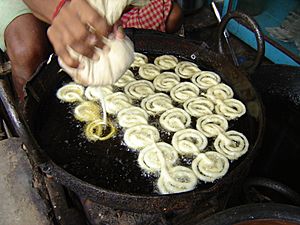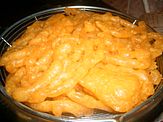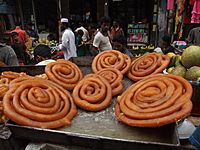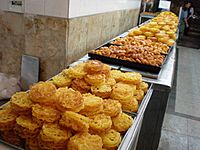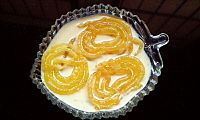Jalebi facts for kids
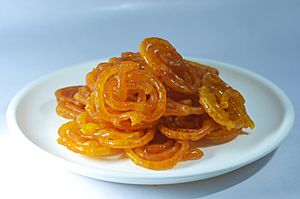 |
|
| Alternative names | jilapi, jilebi, jilbi, jilipi, jelabee, jerry, mushabak, zulbia, z’labia, zalabia, pani walalu. |
|---|---|
| Course | Dessert |
| Place of origin | Western Asia
Regional variants:
|
| Region or state | Western Asia, Indian Subcontinent, Africa |
| Serving temperature | Hot or cold |
| Main ingredients | Maida flour or yeasted dough, saffron, ghee, sugar or honey |
| Variations | Sesame oil, sesame seeds, yogurt, cinnamon, lemon, cardamon, also the shape of the food can change |
| Similar dishes | Chhena jalebi, imarti, shahi jilapi, bamiyeh, lokma, zalabiyeh |
Jalebi (also called Hindi: जलेबी, Bengali: জিলাপি, Odia: ଝିଲାପି, Urdu: جلیبی, Nepali: जेरी, Sinhala: පැණි වළලු) is a super popular sweet snack. You can find it in South and West Asia, Africa, and even Mauritius. It has many different names, like jilapi, jilebi, jilipi, zulbia, jerry, mushabak, z’labia, or zalabia.
The Jalebi from the Indian subcontinent is made by deep-frying a special batter. This batter is made from maida flour, which is a type of plain flour. The batter is shaped into pretzels or circles. After frying, these crispy shapes are soaked in a sweet sugar syrup. People often eat Jalebi with curd or a creamy dish called rabri in North India. Sometimes, they add flavors like kewra (a scented water).
In some West Asian countries, Jalebi might be made from a different kind of dough. This dough is fried and then dipped in a syrup made with honey and rose water. The North African version, called Zalabia, uses a different batter and a syrup of honey and rose water.
Contents
The Sweet Story of Jalebi
No one knows exactly where Jalebi first came from. But we do know about an early Middle Eastern version called zalabiyeh. The first time we see this sweet mentioned in West Asia is in a 10th-century Arabic cookbook. It was called Kitab al-Tabikh, which means "The Book of Dishes." Later, in 13th-century Persia, another cookbook by Muhammad bin Hasan al-Baghdadi talked about a similar sweet.
The word jalebi might come from the Arabic word zulabiya or the Persian word zolbiya. This is according to the Hobson-Jobson dictionary from 1903.
An old Indian story from around 1450 CE, called Priyamkarnrpakatha, mentions Jalebi. It talks about a rich merchant having Jalebi for dinner. Another old Sanskrit book, Gunyagunabodhini, written before 1600 CE, even gives the recipe! The ingredients and how to make it are almost the same as modern Jalebi. Some people think Jalebi might have started in Turkey and then traveled to Tunisia before reaching India. Others believe a musician named Abdourrahman Ibnou Nafaâ Ziriab created it.
The American funnel cake might even be related to these Arab and Persian sweets. It's thought that German immigrants brought it over. So, the exact history of Jalebi is still a bit of a mystery!
Jalebi Around the World
Sweet Treats in India
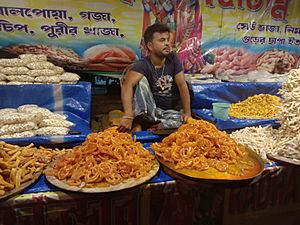
In India, this sweet is known as Jalebi in Hindi. People often eat it with a sweet milk dish called rabri. In northern India, it's sometimes eaten with kachori and vegetable curry. Jalebi is a popular snack in Kerala. It's also a favorite breakfast treat in Uttarakhand and Uttar Pradesh. In other parts of North India, it's a popular dessert for celebrations.
A special type of Jalebi, made from khoya (a milk product), was created by Harprasad Badkul in 1889 in Jabalpur.
Bangladesh's Jilapi
In Bangladesh, this sweet is called Jilapi in Standard Bengali. In some eastern parts like Sylhet and Chittagong, it's called Zilafi. It's a very important food during Ramadan for iftar (the meal to break fasting). Jilapi is a core part of Bangladeshi culture.
Pakistan's Popular Jalebis
In Pakistan, Jalebis are a popular dessert. They are often eaten in homes and at big events like weddings or festivals.
Nepal's Jerry
In Nepal, Jalebi is known as Jerry. This name comes from Jangiri and the Mughal Emperor Jahangir. People usually eat Jerry with Swari, which is a very thin fried bread like Puri (food). It's often enjoyed in the morning with Nepali Masala chiya.
Sri Lanka and Maldives Sweets
Pani Walalu or Undu Walalu is a traditional sweet from Sri Lanka. It's made by frying a type of doughnut from undu flour and rice flour. Then, it's soaked in kithul treacle. In the Maldives, it's known as zilēbi.
West Asian Delights
Iran's Zoolbia
In Iran, it's called zoolbia (زولبیا). Besides being sweetened with honey and sugar, Iranian zoolbias are also flavored with saffron or rose water. In Iran, zoolbia is often served with Persian black tea. It's usually eaten with another egg-shaped dessert called bamiyeh. These sweets are very common during the Ramadan month. They are one of the main foods eaten after fasting.
In Iran, zolbiya was traditionally given to people in need during Ramadan. An old 10th-century cookbook has several recipes for zulubiya.
Azerbaijan's Zulbiya
Zulbiya or zilviya is a special sweet from Ganja, an old city in Azerbaijan. In the past, Zilviya was a main part of the Nowruz holiday. It was usually cooked a few days before Novruz and served on the holiday eve. The round zilviyas, often yellow and red, symbolized the equality of night and day on March 21st.
Arab Countries' Zalabiya
Zalābiya or zalabia (زلابية) is found in the Levant and other Western Asian countries. This includes Arab countries like Yemen, Egypt, Syria, Lebanon, and Iraq.
These are fried dough foods, similar to doughnuts. Zalābiya are made from a batter of eggs, yeasted flour, and milk. Then they are cooked in oil. Unlike jalebi, the West Asian zalabiya can have different shapes, like a free-form doughnut or a ball. It might also contain cinnamon, lemon, and powdered sugar. In Yemen, zalabiyeh is made from a soft yeast bread that is fried. Some people add black cumin for better taste. They are eaten hot, sometimes with honey or sugar.
Zalābiyeh was first mentioned in a 10th-century Arabic cookbook by Ibn Sayyar al-Warraq.
African Jalebi Styles
North Africa's Zlabia
Zlebia or zlabia is a type of pastry eaten in parts of Northwest Africa. This includes countries like Algeria, Tunisia, and Libya. It's made with flour, yeast, yogurt, and sugar or honey. This mix is combined with water and often two seeds of cardamom.
Zlabia is known to be a special sweet from the city of Beja, Tunisia.
Ethiopia's Mushabak
Mushabak or Mushabaka is a popular food, mostly in the Oromo region of Ethiopia. It comes in different shapes and sizes. It's usually covered in sugar syrup or honey. Mushabaka is often baked red. It's frequently served at celebrations and other social events.
Mauritius and Comoros Sweets
In Mauritius, Jalebi is known as "Gateau Moutaille." It has Indian origins. You can also find these sweets in Comoros.
How Jalebi and Zalabiyeh Are Made
Zalābiya mushabbaka are latticed fritters. They are made in discs, balls, and squares. They are dipped in clear honey flavored with rose water, musk, and camphor. An old recipe from a caliph's kitchen suggests adding milk, clarified butter, sugar, and pepper.
Zalābiya funiyya is a "sponge cake" version. It's cooked in a special round pot in a tannur (a type of oven). These are often shaped like sticks. People eat them all year, especially during Ramadan celebrations.
-
Jilapi in Bangladesh is a popular starter at social events.
-
Shahi jilapi, meaning King's jilapi, in Dhaka, Bangladesh. It is the largest form of the dessert.
-
Zulbiā and bāmieh in Iran
-
Jalebi dipped in rabri
See also
 In Spanish: Yalebi para niños
In Spanish: Yalebi para niños


